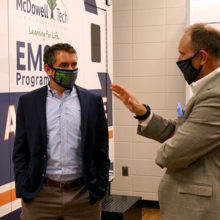Welcome to Awake58! Thank you for reading. If you missed last week’s newsletter on how the smallest community college responded to COVID-19, click here. If you were forwarded this newsletter, please click here to subscribe.
How are colleges allocating the student aid portion of their CARES Act funding? We have some answers… The State Board allocated funding for colleges designed for COVID relief… The recently filed HB 1066 contains the community college system’s legislative priorities, including increasing faculty pay… McDowell Tech’s interim president has been named… And graduations are going virtual…
North Carolina’s 58 community colleges will collectively receive $60 million to provide emergency financial aid to students thanks to the federal Coronavirus Aid, Relief, and Economic Security (CARES) Act. In recent weeks, my colleague Molly Osborne and I met with presidents and administrators across the state to find out how the money will be distributed. Check out our just published story for our findings!
Colleges were allowed to design their own approach. Some decided to disburse the money to all eligible students equally or on a tiered approach. Others decided to use an application-based process, and still others opted for a hybrid model. Presidents of various colleges explained their reasoning in our piece.
We also explore criticism of the CARES Act Department of Education guidelines.
“The [Department of Education] guidance disallowed emergency aid to students with 100% online course loads. The presumption these students were not impacted by our campuses closing is false,” explained Dale McInnis, president of Richmond Community College. “They were deeply affected by the reduction or elimination of student support services, test proctoring, and in many cases, access to technology. Child care, housing, and food issues were not restricted to face-to-face students alone, and those in all online courses deserved some consideration for aid.”
“We are grateful for the funding,” McInnis continued, “but I would hope in the future, community college leaders and our stakeholder organizations will be afforded the opportunity for input in how funds can be better aligned between federal policy and the real and urgent needs of our students and colleges.”
To review the models, explore the guidelines, and see sample applications from some colleges across NC, click below to access our story.
Do you have thoughts on the CARES Act funding guidelines, or a story to share about your college’s approach? Text COLLEGE to 73224 to join the conversation or reply directly to this email.
And be sure to follow us on Twitter @Awake58NC. Just this week we shared videos documenting our virtual visit to Johnston Community College! We also shared videos from Molly’s visit to Nash Community College as they resumed some face-to-face instruction last week.
Have a great week,
Nation
Director of Growth, EdNC.org
State Board of Community Colleges begins spending COVID-19 funds
On Friday, the State Board of Community Colleges began allocating federal funds provided by the General Assembly to address the impacts of COVID-19. The total for the system is $25 million.
The money was allocated in several different ways, including:
→ Almost $3 million of the funds will go to support additional counseling hours at community college small business centers around the state. Community colleges will get $51,724 each.
→ $3 million for additional college and career counselors and academic advisors for community colleges.
→ $250,000 for cybersecurity awareness training for community colleges.
The State Board also voted to waive a requirement for post-course assessment scores for career and technical education (CTE) students in high school. For the full report from the State Board meeting, check out the article here.
Be sure to make note of HB1066. This bill contains some of the community college system’s legislative priorities, including $40.2 million in recurring funds for enrollment growth at the state’s community colleges and $62 million for salary increases of 5% for community college personnel.
Perspective | Amid this pandemic, our 58 community colleges provide hope
Scott Hamilton was named president of the Golden LEAF Foundation in the fall. Hamilton probably did not expect so much of his first year to be dominated by COVID-19 response, but he has found reason for hope in the community college system:
“For all of us, the last two months have been unlike anything we could have ever predicted. This pandemic has dramatically disrupted every aspect of our lives.
But there is hope.
Anchored in communities across the state, the 58 community colleges that comprise one of the most comprehensive workforce development systems in the country will be one of the catalysts for this recovery. The presidents, faculty, and staff of these institutions are the boots on the ground, uniquely positioned to respond to local industry and regional workforce needs.”
For the full perspective, click here.
Perspective | Why can’t colleges use endowments to fill budget gaps?
Even as federal and state governments deliver aid, institutional and student needs continue to mount. Given the need, many have speculated on the possibility of using endowments to meet those very real needs. James Hogan, the vice president of advancement at Mitchell Community College, contributed a perspective addressing this conversation.
“The question itself is rational enough. It seems unjust that Harvard cannot muster the budget to pay its dining services workers when it has $40 billion in the bank.
However, the vast majority of American colleges and universities — and let’s make sure we include community colleges in this conversation — are not Harvard. Not even close. According to a 2014 ACE report, slightly over half of four- and two-year non-profit colleges and universities even have an endowment, with a median endowment value of $7.9 million.
Each of North Carolina’s 58 community colleges has a local foundation that supports their work. Half of the state’s community college foundations have less than $5 million in the bank, however, and the smallest of these has fewer than $500,000 in assets.”
For the rest of his perspective, click here.
Around NC
McDowell Tech’s Ryan Garrison, vice president of finance and administration, has been named interim president. Garrison’s selection was approved by the State Board last week.
Ed Tech Magazine featured Stanly Community College for their transition to virtual learning: “Our program head recorded himself taking a car apart and putting it back together so our students could have the experience of seeing what that would look like,” Enamait says. “Faculty members have been able to leverage the college’s existing inventory of GoPro cameras and a mobile-friendly learning management system to rapidly get this type of content to students.”
A portion of Rockingham Community College’s CARES Act funding for students will be dispersed this month, and their model was spotlighted by the local press. Pitt Community College’s efforts will focus on student aid, online course delivery, and more as we mentioned in our piece linked above. Local media in Eastern NC also documented their approach.
Virtual graduations and drive-through ceremonies are taking the place of normal commencement exercises. Central Piedmont Community College (CPCC) and Forysth Tech released video messages to their student bodies, and Beaufort Community College is planning a virtual graduation.
One bright spot in the last week was the announcement that two CPCC students have been accepted to Ivy League schools.
Russell Lowery-Hart speaks out on COVID-19 strategies
Most weekday mornings, I tweet articles from across the country on our @Awake58NC Twitter account. These include perspectives and reporting on community colleges and broader higher education issues. Follow our account to read the pieces as we tweet them, and check out the links below for some important reads from the last week.
Russell Lowery-Hart of Amarillo College in Texas has received significant attention for his call to redesign the levers of change to support the new “normal” college student — “a mother with two part-time jobs and a pile of bills.” TalkPoverty.org spotlights his work during COVID-19 in a piece out now.
Two questions and responses stood out to me:
Have you seen basic needs insecurity among Amarillo College staff, or adjunct instructors, in the past or since this crisis hit?
Russell Lowery-Hart: “I think it existed before, but I don’t know that I had to see it like I see it now. [One of our staff] has taken two bags of food home with her. If we hadn’t lifted the restrictions, I don’t think she would have ever asked for it. It’s one of the reasons why, with our CARES Act funds, we’re creating an emergency aid system not just for our students, but also for our employees.”
You have criticized the CARES Act for prioritizing full-time students over part-time students in the formula that determines the funds available to each college. How can we better support community colleges and today’s students?
Russell Lowery-Hart: “If you want to make stimulus money have the biggest impact with the lowest level of investment, it’s community colleges. The CARES Act is helpful. I don’t want to complain about the help that we’re going to be able to give students. But that money is also going to support for-profit colleges and universities that have huge endowments.”
“If you look at what we could give in emergency aid to our students [from CARES], you’re looking at $250 per student. And that’s not going [to] manage a crisis for our students.”
Other higher education reads
Strada will host a webinar May 20 focusing on how enrollment in postsecondary education and training programs could shift. This webinar will provide tips and recommendations for responding to potential changes due to COVID-19. Sign-up by clicking here.
The Chronicle of Higher Education now has a live tracker looking at colleges’ plans for reopening, or not, for the fall. Check it out.
Hechinger Report is raising an issue of increasing importance in recent years in a recent piece — students taking out private loans as college tuition increases. The fear? “The private student loan market is the wild, wild west of consumer finance in terms of the lack of protection, the lack of accountability, the lack of oversight.”
CC Daily has a new article arguing that community colleges might offer a path forward for families suddenly facing complex decisions around fall enrollment in higher education: “During these unprecedented times, families with college-age children face difficult decisions about what to do for the fall semester. In an April Art & Science Group poll of graduating high school seniors, more than half reported that a parent or guardian had lost their job or been furloughed, and one in six who had previously planned to attend a four-year school in the fall were near the point of giving up on those plans.”
Sign up for more from EdNC.org!
Sign up for all of our EdNC.org newsletters for all of the latest news and information.
A lot is happening in early childhood education! Sign-up for Early Bird to receive the latest news — including the latest information on early childhood educator prep.
Every single day, we cover the biggest stories affecting all of our students. Sign up for the Daily Digest to receive the news each morning!
For a weekly rundown on important stories from across North Carolina, subscribe to EdNC’s Weekly Wrapup.
Weigh in on weekly conversations about policy issues in North Carolina by joining Reach NC Voices.
Policy research, trends, and analysis from around the country have an impact on our state. Subscribe to Friday@5 to find out the latest each week!



